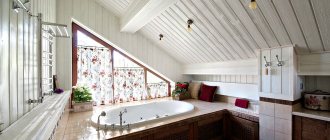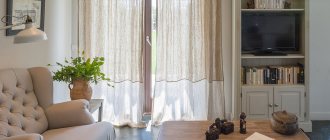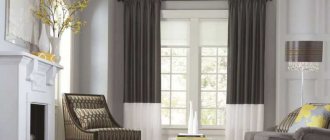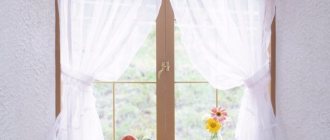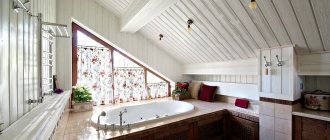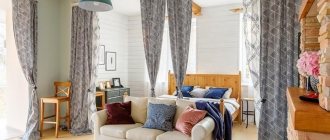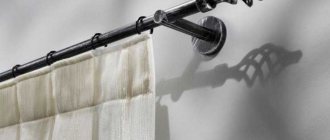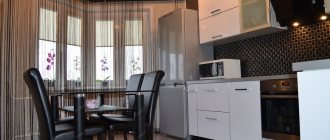Linen fabric is one of the few that is still produced from natural raw materials. It is widely used for tailoring and interior decoration. Consumers highly value this fabric, which pleasantly “cools” in hot weather and absorbs excess moisture, allowing the body to “breathe”. The material is light but dense. Linen fabric has a rough, pronounced fiber texture. The uniqueness of the material lies in its versatility. From threads, depending on their thickness, you can weave both the thinnest tulle and thick fire hoses. Linen curtains are a stylish and extremely beautiful decoration. Let's talk about an amazing plant and the decorative fabric that is made from it.
About flax: history, production and interesting facts
The discoverers of flax were the Indians. Almost 10,000 years ago, linen was first made here. Gradually it replaced the “natural” material - animal skins. The plant began to be grown everywhere. Unique linen fabrics were woven in Ancient Egypt. Due to its incredible lightness, the fabric has been compared to “baby breath.” For clarity: 1 kg of yarn consisted of a thread approximately 240 km long. A modern ball of similar weight unwinds 30-40 km. The linen fabric turned out to be so thin and weightless that, folded in five layers, it was still slightly translucent. Any item of clothing could be passed through the ring. In Egypt, the loss of the harvest of this plant was considered a real disaster. Linen items were highly valued in ancient times. The cost of the canvas was determined using scales. A thing was placed on one bowl, and gold according to its weight on the other. Only wealthy people, mainly priests, dressed in such clothes. Linen ribbons (bandages) were also used for mummification. They are perfectly preserved, as evidenced by the finds of Egyptologists. Some critics skeptically note that the bandages were soaked in balm, which “preserved” them, but linen fabric itself lasts a long time. It is believed that the secret of the “weightless” material has been irretrievably lost.
In Rome, linen was preferred by women. In Rus', plant cultivation began late - only at the beginning of the 11th century. The material was woven only for their own needs. Only by the middle of the 18th century did Catherine II give official permission to export fabric. In Europe, for a long time, linen was considered the preserve of wealthy families. Although the cost of fabric fell in comparison with Egyptian prices, it still remained high. It was only after the Renaissance that even the poor could afford such things. Now flax is grown everywhere. In recent years, there has been a real boom in natural fabrics. Cotton, although lower in cost, clearly lost to flax in this competition. The point is the unique properties of hypoallergenic fabric, which is not only pleasant to the skin, but also treats burning, itching and other signs of irritation. Special varieties of flax are used to make fabric. First, the plant is soaked, then dried and thoroughly crushed. The resulting blocks of raw flax are sent to the spinning mill, where they are made into threads.Types of fabrics
Depending on the purpose, linen fabrics are classified into the following types:
- Linen. They are used for sewing underwear and bedding. As a rule, the material is bleached.
- Towels. The fabrics are used for sewing towels.
- Dining rooms. Bleached or plain-dyed fabrics from which tablecloths and table napkins are sewn.
- Clothes. This material can be either plain or with a pattern on the surface. The fabric is used for making clothes. Things can be used both in summer and winter. In addition to feeling cool in hot weather, linen provides great warmth.
- Applied. Used for making small decorations (mainly for clothing).
- Decorative. This type of fabric is used for interior decoration. Decorative fabric is mainly used to make curtains, upholstery or pillowcases for decorative pillows.
There is also a classification according to weaving types:
- Twill.
- Linen.
- Large patterned.
- Finely patterned.
- Openwork.
- Satin.
Depending on the density of linen fabric and the method of weaving the threads, the material is divided into subtypes:
- Canvas. Used to make painting canvases.
- Tarpaulin and canvas. Used for sewing tents, raincoats and waterproof specialties. clothes. The material is woven from thick fibers and impregnated with special water-repellent compounds.
- Sackcloth. Bags are made from this coarse type of linen fabric, but the material is often used in decoration due to its special texture.
- Batiste. Lightweight material is intended for sewing clothes and sophisticated lingerie.
- Damask. A thick type of linen fabric that is used for sewing curtains and furniture upholstery.
- Crinoline. Thick lining fabric.
In addition to the above types, there are also kolomyanka, fine linen, ravenduc, matting and teak. All except the last one are mainly used for sewing clothes (from summer dresses to men's suits).
Visher flax is also found. This is a combined natural-synthetic material. It is almost 80% polyester, with the remainder being linen and spandex.
In different rooms
Linen curtains on the windows will give any room comfort and an atmosphere of simple chic. In particular, this property of matter is often used for the living room. When choosing curtains for the hall, the owners always strive to make the room impress their guests. Linen curtains, despite their apparent modesty, perform this task perfectly. The use of natural materials always looks expensive and stylish.
When choosing linen curtains for the bedroom, they often opt for floor-length options. Shortened curtain models are practically not used in this case. Linen curtains perfectly protect the room from street noise, and also allow you to equalize the temperature background in the room.
By covering the radiator, they slightly cool the air before blowing it into the room; Curtains also prevent drafts. This atmosphere in the bedroom is conducive to good sound sleep.
Medium-length linen curtains for the kitchen are a classic of the genre. Housewives often opt for this particular option, since linen washes well, does not absorb odors, and also looks harmonious. Roman blinds for the kitchen are often made from linen because they are more practical than regular sliding curtains.
Linen curtains are also used in the nursery, although they mainly serve a decorative function. Light curtains made of bleached linen are suitable for both boys and girls.
Advantages and disadvantages of linen curtains
Linen material has a lot of advantages:
- Strength. Wear resistance. Linen fabric is not easy to fray or tear. If we are talking about dense material (burlap, canvas, teak), then it is generally impossible to make a hole in it without sharp objects.
- Resistance to chemical compositions containing acids. Such products make flax softer.
- Eco-friendly and hypoallergenic. If you use the material to make furniture upholstery, then anyone can sit on such a chair or sofa, even with problematic or hypersensitive skin. The same rule applies to linen clothing.
- Breathability. The material “breathes”.
- Low peelability. No pellets are formed on the surface of the material. It doesn’t matter how long the fabric has been used.
- Does not contribute to the generation of static electricity, that is, it does not become electrified.
The disadvantages of linen fabrics include:
- Low elasticity. The material has almost no stretch.
- Lack of alkali resistance. When exposed to such compounds, linen fabric loses strength.
- A number of features when washing. Linen cannot be called a capricious fabric, but boiling even white fabric is prohibited. You can't soak it before washing either.
- Burning out under the sun's rays.
- High price.
Another serious problem is the formation of “wrinkles”, which are typical for flax, and high creasing. The material does not “hold its shape” at all after ironing. A couple of awkward movements are enough and the curtains will look wrinkled. This deficiency is especially acute in clothing. Home textiles just need to be carefully placed in their proper place and not touched unnecessarily.
Variety of color palette
Linen fabrics are given a wide variety of colors. However, more often there are muted tones: mustard, khaki, gray, olive, lilac, blue, beige, peach, cream, pearl. Delicate shades are universal and will suit any interior. Calm tones look great in a classic setting. In addition, linen fabric is considered non-marking, which significantly increases the period of use of curtains between washes. Quite often, natural canvas is decorated with drawings. Usually these are floral motifs and elegant script. Large prints, as well as bright contrasting shades, are also rare. Linen tulle is often decorated with embroidery that harmonizes with the pattern of the curtains. There are also two-color curtains, in which the shades are selected according to the principle of analogy. This option will help tie together the different colors used in the interior into a single composition.
Colors and shades
Linen fabric for curtains has been used for centuries. One of its aesthetic advantages, which gives the curtains a unique charm and makes their design unique, is their natural color - natural, natural, but not monotonous. It is due to the characteristics of natural raw materials and has colors that are pleasing to the eye, close to natural tones: from blurry whitish to dark gray and light beige. Today, everything natural is in trend and such textiles are the most popular. But this does not mean that the wealth of choice is limited to natural, unprocessed colors.
The colors of linen curtains are:
- Made from unbleached linen. This textile is reminiscent of hand-woven fabric on an ancient loom and is distinguished by a coarse, clearly visible weave in gray or brown shades. It is ideal for antique-style “rustic” interiors.
- Made from bleached flax. The weave is not as coarse as that of unbleached textiles, and the shades of gray and brown are several shades lighter, ranging from medium rich to off-white. This color scheme gives the curtains a sophisticated and sophisticated touch and is suitable for a wide variety of interior styles.
- Made from colored linen. If desired, linen curtains can be dyed. But due to the high content of fatty and waxy substances and the structural features of the fibers, the color of the fabric turns out muted, as if washed out or slightly faded. It looks very stylish and, thanks to the richness of colors, such curtains are widely used in rooms for a wide variety of purposes: from residential interiors to commercial ones.
More vibrant colors are obtained using printed patterns (printing), appliqués or weaving with other types of threads. Both bright and delicate and elegant embroidery in light colors look great on linen.
On sale you can often find a large selection of so-called “linen-look curtains” made of 100% polyester, both natural and bright colors. They don't have most of the benefits of natural products, but they look almost the same and cost about half the price.
In order not to make a mistake with the composition of the fabric, its naturalness can be easily checked. You need to set fire to a small piece of it. If after it burns, only crumbly ash remains - natural flax.
What styles are used?
Linen curtains are universal. The pronounced texture of the material is ideal for eco-style, country, classic, and modern. The best option would be linen curtains for the Scandinavian trend, which celebrates naturalness and laconicism. The material drapes well, so the curtains are suitable for solid interiors decorated in ethnic (English, Italian, Dutch, German) styles. Simple burlap curtains harmonize with the unpretentious rustic decor of a Russian hut or the decoration of a house lost in the French outback (Provence). Linen fabrics do not combine with luxurious styles that require richer fabrics. For example, curtains in the Empire, Rococo, and Baroque styles will look inappropriate.
What kind of linen curtains are they?
They look cozy, unusual and stylish at the same time. The photo gallery of linen curtains clearly demonstrates how warm it becomes in a room with a window covered with natural linen, how softly the sunlight pours through this natural fabric, and how homely it feels in the evening in a room in a chair by a floor lamp near a window with linen curtains . The room with them even looks somewhat mysterious if there is also a linen tablecloth on the table, and the same cape on the sofa.
For the kitchen interior, this is just a godsend, if there are also linen towels, you will want to spend more time in the kitchen, linen is a natural material, looking at it you want the real thing - vegetables, herbs, stews and country pies.
Such curtains are very good in the living room, despite the dull tones of linen fabrics, they themselves are practically the main detail and decoration of the interior - and immediately attract the eye.
It will not be difficult to furnish a room with them - the furniture may be very simple, and there may be little of it - the room will still seem elegant and a little solemn, since linen fabric, if it is carefully ironed, shines slightly.
There is no need to starch such curtains - the material holds its shape perfectly and lays beautifully in natural large, soft vertical folds.
Tips for choosing
When choosing linen curtains, you should listen to the advice of professional designers and ordinary people who “ate the dog” when decorating their homes:
- Linen goes great with cotton. Natural fabrics form an original multi-textured combination.
- To prevent curtains from wrinkling so much, you should choose linen fabric with the addition of viscose.
- Linen fabric, richly decorated with lace, is suitable only for ethnic trends. It looks outdated and is associated with typical interiors.
- Rough texture looks best on thin fabric. Translucent linen curtains are a must-have attribute of marine and Scandinavian styles.
- For the bedroom you cannot choose a material that imitates natural linen. If the composition contains synthetic fibers, then this will negatively affect the ability of the fabric to “breathe” and its environmental friendliness.
- If the curtains are decorated with a pattern, then it must echo the pattern on the upholstery or wallpaper.
- For country style, choose simple burlap curtains, which are decorated with openwork garters. This decorative attribute is easy to make with your own hands.
In modern styles, laconic plain floor-length curtains are more often used, which easily adapt to both wooden and metal surfaces in the interior.
Caring for linen curtains
With proper care, curtains made of linen fabrics can last for many years without losing their presentable appearance. The basic rules for caring for them are quite simple and will not cause any special trouble. Basic recommendations on how to wash linen curtains are as follows:
- Before washing your curtains, test a small area to see if your specific detergent is suitable for them. If a stain appears on the fabric, it is better to treat only the area where it is located rather than washing the entire curtain.
- Machine washable, but gentle, preferably with natural detergents and without spinning. In this case, it will be much easier to smooth out the linen.
- Even if there is no special warning in the fabric care instructions, you should never use bleaches or aggressive powders or gels.
- Linen products should be ironed slightly damp, under-dried or with a steamer. Please remember that there is always a possibility that the fabric will shrink.
- It is better to wash dyed items in warm water at a temperature not exceeding 40 degrees without the use of bleaches. Unbleached and bleached linen without appliques and embroidery can be washed at 90 degrees.
Linen curtains are suitable for people who prefer natural materials and who value, above all, naturalness and practicality in the interior. Eco-friendly and stylish, they add a special charm to the environment, add notes of cozy reliability and tranquility, and serve their owners for many years without losing their attractiveness.
How to hang
Linen curtains are usually hung in two ways:
- On the eyelets.
- On the curtain tape.
The second option looks modest, but neat. If the window decor should be accentuated and eye-catching, then it is better to use stylish metal eyelets and the same cornice. It is not recommended to complement linen curtains with bandeaus or lambrequins, as this contradicts the concept of laconism, which is supported by the textured material.
Achieving complete harmony
- Curtains in the living room cannot but harmonize with home textiles. Window decoration is well complemented by a linen tablecloth or covers for chairs and armchairs.
- Dark linen on the windows looks great with the beige-brown color scheme of the room. It also works well in green and white living rooms.
- Light fabrics look great in soft yellow, bluish or creamy caramel living rooms. Their contrast is original in rooms with a dominance of purple, blue or peach-orange.
Deciding on the length
There are no length standards for linen curtains. For the kitchen, short curtains are traditionally chosen that reach the windowsill or radiator. In the bedroom, living room, and children's room, it is better to use long curtains. In order for the curtains to look neat, their length should end on some horizontal surface: a window sill, a heating radiator, the floor, a desk placed against the window. The material should not be allowed to “hang out”. Curtains that are too long not only get dirty faster, but also look very untidy.
Interior design with white tulle: features of combination with walls, wallpaper, furniture
Designers agree that white is the strongest color and it looks quite self-sufficient. This means that you need to choose a “company” for him carefully. In addition, the texture of white tulle is important.
White is a very “independent” color, it is difficult to identify a shade that would clearly not suit it
Pure white is a cold color, which means the best complement to it is warm-colored curtains. At the same time, both the curtain and the tulle can be plain, without a pattern. If preference is given to fabric with a pattern, embroidery or ornament, then a simple rule is relevant: the pattern should be either on the tulle or on the curtain.
Embroidery on the curtain takes us back to folk traditions
It is recommended to complement complex designs with lambrequins, ties and additional decor with the most laconic tulle without folds or ruffles.
The photo of the interior with white tulle shows how important it is to choose the right furniture and other interior elements. The lamp, table and even the shape of the bed are unusual, but harmoniously complement the overall concept of the design solution.
With the help of tulle it is easy to change the image of a room by choosing a different drapery or curtain length
White tulle in the hall will not only make the room brighter, but also visually enlarge it. This is especially true for living rooms with low ceilings. With the help of snow-white fabric and the correct design of curtains, you can correct the situation. Proper design of the ceiling and lamps of the correct shape will complement the effect.
Black and white window design is at the peak of popularity. The main thing is that the pattern of such tulle is combined with interior details (pillows, for example), and does not “argue” with the furniture, wall decoration and floor covering.
Dark curtains will stand out in the interior if the furniture is a couple of shades lighter
In this case, it is better to abandon curtain fabric altogether. If this is not possible, the fabric should not be in bright colors; it is better to stick to black and white.
Fearing that window decoration in white colors will look official or like in a hospital, you can choose curtains with embroidery. For the bedroom this is a great option. A special atmosphere of homeliness and comfort is immediately created.
Curtains with embroidery in the interior of a modern bedroom
Care: how to wash, iron and whether to starch
Liquid powders are used to wash linen curtains. They dissolve better in water. Select the “gentle wash” mode on the machine. Do not boil linen fabric (even white). It is advisable to starch only thin, translucent linen curtains or tulle. You can prepare the composition yourself: “cook” the starch in water, cool, dissolve in a bowl and rinse the curtains in it. It is difficult to iron linen fabric. It is especially difficult to cope with large canvases. While one area is being smoothed, the other may be wrinkled again by this time. It is not recommended to steam the material. In a situation with flax this is useless. The iron needs to be very hot and carefully iron out every wrinkle. The treated part of the curtain must be carefully straightened and moved to the side, not allowing it to fall onto the floor from the ironing board. Preliminary drying of the material in a suspended state will facilitate the ironing process.
Pros and cons of flax
Whatever fabric interests us, we always pay attention to its properties. Even an amateur knows that cotton shrinks a lot, and wool does not tolerate high temperatures. Let's figure out what will please us and what will upset us about flax.
Clean, without additives, the fabric wrinkles very much. And this is perhaps the main disadvantage of natural flax. After washing, you will have to iron your linen curtains for a long time and carefully so that they become smooth and beautiful again.
Delicate pistachio and beige shades in the bedroom
Linen allows air and heat to pass through well, which is certainly beneficial for human health. The material does not cause allergic reactions and is highly environmentally friendly.
Linen curtains will add coziness to your interior
Flax fiber is very durable, which gives it a long service life. There are cases when grandmothers passed on linen products that had gone through many washes, but retained a presentable appearance.
Washing causes linen to shrink by 7%. Remember this: when calculating the footage of curtains, buy fabric with a margin.
Advice: refrain from using aggressive detergents to wash curtains. Under the influence of chemicals, linen quickly becomes thinner and loses its original attractiveness. Linen should not be bleached with substances containing chlorine; it may become stained.
Linen curtains in the interior
Linen curtains can easily be integrated into the interior of any room. They look stylish both in a wooden private house and in a modern city apartment. For each room, depending on the stylistic decision and functional purpose, a material of a certain color, density and composition is selected.
Living room
Luxurious two-color curtains with eyelets will emphasize the simplicity and naturalness of the Scandinavian living room interior. They combine the white color of snow and blue, turquoise, royal blue shade of ice. This solution will echo the soft “skin” on the floor near the sofa, a glass coffee table, light wood furniture and simple decoration. For a living room decorated in a rustic style, light curtains in brown tones with an unobtrusive floral pattern are suitable. They are tied with curtain ribbons and decorated with white openwork garters. The pattern of the canvas echoes wallpaper with small flowers, patterns on the upholstery of upholstered furniture or decorative pillows. Forged elements and wooden surfaces will complete the composition. The sweet, naive simplicity of country style in the living room is emphasized with a bouquet of fresh flowers on the windowsill.
Bedroom
For a modern bedroom, choose thick linen curtains in calm shades: turquoise, olive, walnut, coral, yellow. There is no need for contrasts in the rest room. To visually add height to the bedroom, use a combined technique of attaching tulle and curtains. The top panel is fixed directly to the tubular cornice, and the inner one is hung on rings. A single composition is formed by curtains and tulle made of linen, but of different shades and densities. Floor-length curtains with simple ropes instead of ornate garters will suit minimalist bedrooms. A classic interior with an accent niche at the head of the bed, decorated with wallpaper in large flowers, is emphasized by double-sided linen curtains. From the outside the canvas is white, but inside it is painted in a contrasting shade (olive, cranberry, lingonberry).
Kitchen
For the kitchen, it is better to choose short curtains that “rest” against the radiator or window sill. Since the curtains in this room will absorb odors and be subject to frequent washing, it is better to choose linen with the addition of viscose. It's easier to smooth out. Among the shades, it is recommended to choose warm tones: pear, titian, corn, madder, amber, salmon, cinnabar, ocher. If the kitchen is combined with a dining room, and the dining group is located in the bay window, then choose long floor-length curtains. Instead of tiebacks, the canvases are decorated with matching magnetic brooch clips. You can independently weave an original and laconic fastening from ropes, straps or wire and beads. Branches of artificial plants with rare inclusions of buds instead of tiebacks will create the mood in the kitchen and ideally match the rough texture of flax. The sweet and rustic decor of the room is emphasized by short curtains with a pattern of small flowers. They are additionally decorated with a simple cotton lambrequin in a playful check. The colors of matter are selected according to the principle of analogy. It is not advisable to combine lambrequins with linen curtains, but the rustic atmosphere of the kitchen encourages experimentation. For a room decorated in a marine style, curtains are selected in two colors: sandy yellow and sea turquoise. Both shades are often used in beach house interiors. Turquoise tiles on the kitchen splashback and snow-white furniture will complement the composition.
Choosing a color for curtains
As we have already said in our other articles, the choice of curtain color depends on the entire interior composition. Will they overwhelm the room or go unnoticed? Everything again depends on the color schemes.
Curtains for the kitchen made of bleached linen in the same white interior will look gentle and elegant, but at the same time they risk going unnoticed. Therefore, if you want to make a bright accent in a bright room with curtains, choose colored fabrics.
You should also be careful with bright linen curtains. Dark wallpapers will refresh light curtains, and bright ones will clutter up the space, so we’ll leave them for light rooms. If the room has patterned walls, then the curtains should either have the same pattern or be plain to match the wallpaper. Curtains with a light, unobtrusive pattern will dilute boring plain walls.
Curtains in cold colors will give coolness to warm southern windows: blue, light blue or gray tones. The northern side will be warmed by warm shades: light yellow, pink, golden curtains.



